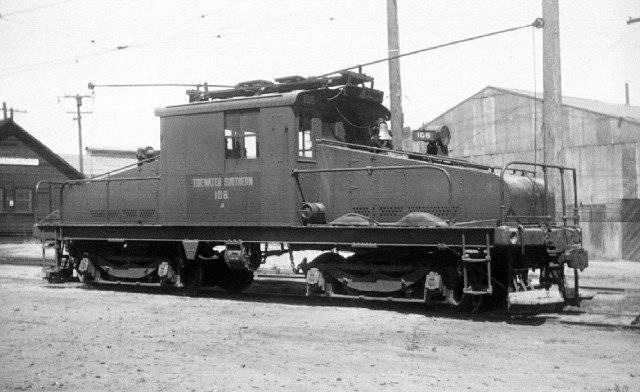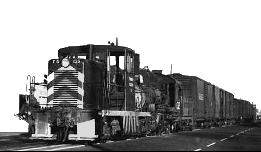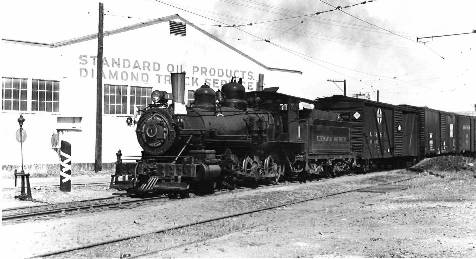| Page
7
The Roster
See also: All-Time Roster In the early days, the Tidewater Southern rostered both electric and steam locomotives for freight service, and the three afor-mentioned Jewett interurban cars to hold down passenger duties. The Tidewater also leased additional cars on as-needed from the Central California Traction Company, usually during peak holiday periods. However, a transportation revolution was taking place throughout the country and the Central Valley was no exception. That nasty, smelly, noisy horseless carriage had grown up along with its big-bruiser brother, the Bus, and was taking patrons from the rails by the droves. The 1929 Stock Market crash and resulting Great Depression didn't help either. This resulted in TS management announcing their intention in 1932 to throw in the towel on passenger service. That year found the railroad petitioning for and receiving permission to cease passenger service, allowing the company to store their Jewett cars and concentrate on hauling freight. |
||
|
That same year,
management decided to cease all electric operations and rely solely on
steam to power its trains. Thus the order was given to pull down the 33
miles of electrified mainline between Stockton and Aurora siding in Modesto.
This salvage job lasted close to a year, commencing in 1932 and finishing
up in 1933. But before crews could get to the catenary in downtown Modesto,
they were stopped on their tracks, so to speak.
When Modesto city fathers caught wind of the Tidewater's plans to operate smokey, sooty steam engines through their fair city, they were not smiling. |
|

GE-built 106 sits at the Modesto Tie-up between trains in 1947. (click on photo to enlarge) Shade Tree Books Collection |
The crux of the
problem was the fact that the railroad had constructed its mainline in
the downtown section of the city by laying it right down the middle of
Ninth Street, a major thoroughfare in the heart of the business district.
The solution for Modesto was to keep an ordinance on the books that prohibited steam locomotives from operating on city streets. This forced the railroad to keep their pair of electric steeplecab locomotives on the roster until 1947 for the sole purpose of escorting steam-powered trains through Modesto. Thus the railroad, for time, rostered a very eclectic collection of steam, electric and finally, diesel power. |
|
|
The Electrics Two electric freight motors were purchased by the Tidewater and numbered 100 and 106. These two locomotives became a fixture in the waning years of catenary, calling Modesto home until the railroad was able to take delivery of a new G.E.-built 44-ton diesel in 1947. The 100 and 106 were rather typical as far as the steeplecab electric design went. First on the roster was the 100, purchased from the Central California Traction Company in 1914, a mere two years after being built in te CCT's Stockton shop. No. 100 The 100 was a great example of early 20th Century freight motor technology, sporting a wood-sheathed cab and body set on top of a steel underframe. No. 100 was built in 1912 by the CCT in their Stockton shop and was sold to the Tidewater Southern for use on construction trains supplying the line crews with material as they made their way south towards Modesto and Chemurgic. Once the entire railroad was open for business No. 100 settled into the work-a-day routine expected of her, and was eventually joined in 1921 by a second freight motor to assist with the growing traffic base. The 100 was finally retired in 1947 and sold for scrap a year later, in 1948. No. 106. Next to come along was the 106, a General Electric-built steeple cab sporting an all-steel construction. This unit was delivered to the Tidewater in 1921 to help the railroad better cope with an increasing traffic flow. It was not uncommon for the tiny short line to borrow one or two steam engines from parent WP with power became tight. Disposition. In 1948 the Tidewater Southern was sufficiently dieselized with new-fangled diesel-electric locomotives to cover their daily assignments. The delivery by General Electric of a pair of somber-black 70-ton units meant that the company finally retire the 106 and transfer it to big sister Sacrament Northern. The now-ancient 100 was sold for scrap the following year. By now the railroad was well aware of Modesto's intention to block any efforts by the Tidewater Southern to standardize on a single mode of power. (i.e. steam power). Lest Modesto decide to ban smelly diesels too, the last remaining catenary on the railroad was quickly removed. |
||
| Tidewater
Teakettles
In addition to electric locomotives, the Tidewater rostered three steam locomotives: Two different 1-spots (officially rostered as No. 1), and No. 132. First No. 1, was a small engine used primarily as a construction locomotive while track crews graded roadbed and laid rail. It Second Engine No. 1, a product of the Rome Locomotive Works, had a long and glorious history. It started life as Rio Grande Western 39 and was delivered to that railroad in January of 1891, the same year Rome delivered Sierra Railroad's now-famous movie steamer, No. 3. It eventually found its way to the West Coast and sold to the fledgling Western Pacific as their 126. In 1918, a year after the Tidewater Southern was acquired by WP, No. 126 was transferred to the power-hungry railroad and renumbered to Tidewater second No. 1. Tidewater No. 132 was the last of its breed on the TS, closing out the railroad's steam era. The locomotive held a special place amongst followers of California shortlines because of its history as a former part of the Sierra Railroad's roster. Delivered in September of 1923 to the Sierra as their No. 32 , the Baldwin 2-6-2 was sold to the Tidewater on May 8, 1940. The locomotive's Sierra number stayed on the engine's cab sides until June 16, 1941, when it was renumbered 132 to eliminate a conflict with WP's 2-8-0 No. 32. Over the years, the Tidewater Southern has been the subject of a number of railfan excursions, most originating in the San Francisco Bay Area. One of the more interesting trips was a April 27, 1952 Oakland-to-Turlock roundtrip trip featuring sole survivor No. 132.
|
||

